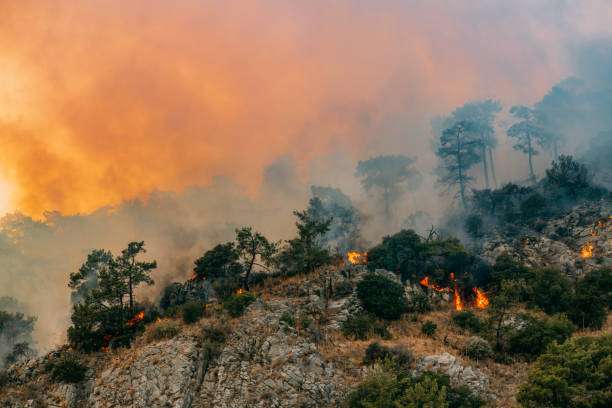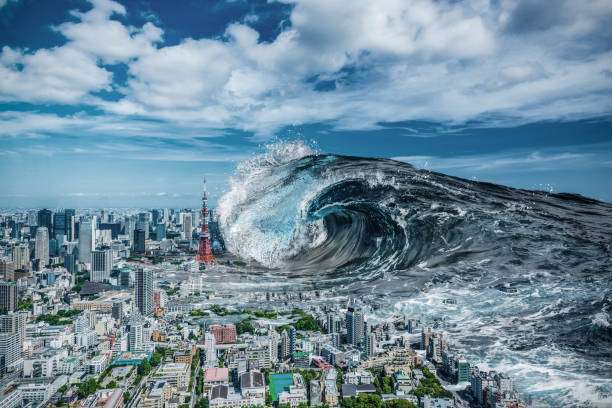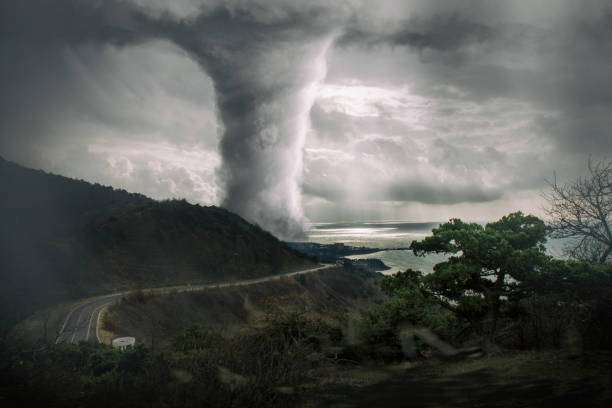Top 5 Reasons Why Natural Disasters Occur

September 04, 2023
Natural disasters occur due to a combination of natural processes and factors. While it's challenging to pinpoint specific causes for each event, here are the top five reasons why natural disasters happen:
Tectonic Plate:
Earthquakes, volcanic eruptions, and tsunamis are often the result of the movement and interaction of tectonic plates. The Earth's crust is divided into large plates that float on the semi-fluid mantle beneath them. When these plates collide, pull apart, or slide past each other, it can lead to geological events such as earthquakes and volcanic activity.

Weather and Climate Conditions:
Many natural disasters are weather-related. Hurricanes, tornadoes, floods, droughts, and wildfires are influenced by atmospheric conditions and climate patterns. For example, hurricanes form over warm ocean waters, while droughts can result from prolonged periods of low precipitation.
Human Activities:
Human activities can contribute to the occurrence or exacerbation of natural disasters. Deforestation, urbanization, and land-use changes can lead to increased vulnerability to floods and landslides. Additionally, activities such as mining, drilling, and the construction of large reservoirs can induce earthquakes or alter natural processes.
Climate Change:
Climate change, driven primarily by human activities like the burning of fossil fuels and deforestation, can intensify and alter the frequency of natural disasters. Rising global temperatures can lead to more extreme weather events, including heatwaves, heavy rainfall, and more powerful hurricanes, exacerbating the impact of these disasters.
Geology:
Geology like the type of bedrock, fault lines, and the location of mountain ranges can influence the occurrence of natural disasters. For example, areas near tectonic plate boundaries are more prone to earthquakes and volcanic eruptions. The presence of fault lines can lead to land movement and seismic activity.
It's important to note that natural disasters often result from the convergence of multiple factors, and predicting their occurrence with precision can be challenging. Preparedness, early warning systems, and mitigation efforts are essential to reduce the impact of these disasters on human lives and property.
How to Prepare for Natural Disasters in India
India is prone to a variety of natural disasters, including earthquakes, floods, cyclones, droughts, landslides, and more. Preparing for these events is crucial to ensure the safety and well-being of yourself and your loved ones. Here are some steps you can take to prepare for natural disasters in India:
Stay:
Keep yourself updated with information from reliable sources such as the India Meteorological Department (IMD) and local authorities. Follow weather forecasts, early warnings, and advisories to stay aware of potential disasters.

Emergency Kit:
Prepare an emergency kit that includes essential items such as non-perishable food, water, a flashlight, batteries, a first-aid kit, important documents, and any necessary medications. Ensure your kit is easily accessible and regularly check its contents for expiration.
Family Emergency Plan:
Create a family emergency plan that outlines how your family will communicate and where you will meet in case of evacuation. Make sure all family members are familiar with the plan.
Home Safety:
Make your home more disaster-resistant by securing heavy furniture, installing earthquake-resistant fittings, and reinforcing your roof. Ensure gas and electrical connections are safely installed.
Evacuation Plans:
Familiarize yourself with local evacuation routes and shelters. If authorities recommend evacuation, follow their instructions promptly.
Insurance:
Consider purchasing insurance policies that cover natural disasters, such as flood insurance or earthquake insurance, if applicable. Review your existing insurance policies to understand your coverage.
Preparedness:
Maintain an emergency fund to cover immediate expenses in the aftermath of a disaster. Keep some cash on hand, as ATMs and electronic payment systems may be unavailable during emergencies.

Community Involvement Programs:
Get involved in local disaster preparedness and community organizations. Participate in drills and exercises to improve your readiness.
Educate Yourself:
Learn basic first aid and CPR. This knowledge can be invaluable in providing immediate assistance to yourself and others during emergencies.
Stay Calm:
If a disaster strikes, stay calm and follow the instructions provided by local authorities. Monitor news and weather updates to stay informed about the situation.
After the Disaster:
After the event, check for injuries and administer first aid as needed. Avoid damaged buildings and downed power lines. Be cautious of contaminated water and food. Follow government guidelines for recovery and rebuilding.
Rehabilitation:
Support and contribute to recovery and rehabilitation efforts in your community. This could involve volunteering, donating, or providing assistance to those in need.
Natural Disaster Management: A Comprehensive Guide
Natural disaster management is a crucial aspect of safeguarding lives, property, and the environment when facing events like earthquakes, hurricanes, floods, wildfires, and more. Here's a comprehensive guide to natural disaster management:
Preparedness:
a. Risk Assessment: Identify the types of natural disasters that are most likely to occur in your region and assess their potential impact.
b. Community Education: Raise awareness within your community about the risks and hazards specific to your area. Educate residents on how to prepare for disasters.
c. Emergency Plans: Develop and communicate comprehensive emergency plans for your household, workplace, and community. Ensure that everyone understands their roles and responsibilities during a disaster.

d. Emergency Kits: As mentioned earlier, assemble emergency kits with essential supplies and documents. Make sure each family member or employee knows where to find these kits.
Early Warning Systems:
a. Stay Informed: Regularly monitor weather forecasts and updates from relevant authorities.
b. Install Alert Systems: Use available alert systems, like weather apps, radio, and local alert systems, to receive timely information about approaching disasters.
Shelter:
a. Evacuation Plans: Know the designated evacuation routes and shelters in your area. Develop a personal evacuation plan for your family or organization.
b. Transportation: Arrange transportation options for evacuating people and pets, if applicable.
Mitigation:
a. Building Codes: Advocate for and enforce strict building codes and regulations to ensure that structures are designed to withstand disasters like earthquakes and hurricanes.
b. Land Use Planning: Implement land use planning that takes into account the potential risks of disasters. Avoid building in high-risk areas.
c. Vegetation Management: In wildfire-prone regions, maintain defensible spaces around homes and buildings, and remove dead vegetation.
d. Infrastructure Resilience: Upgrade and retrofit critical infrastructure to make it more resilient to natural disasters.
Response:
a. Activation of Plans: When a disaster occurs, activate your emergency plans and coordinate with local authorities.
b. Search and Rescue: If safe, assist with search and rescue efforts and provide first aid to those in need.
c. Communication: Establish communication channels for information dissemination and coordination with local authorities, community organizations, and neighboring areas.

Recovery:
a. Assessment: Assess the extent of damage and prioritize recovery efforts.
b. Assistance: Provide assistance and support to affected individuals and communities, including access to food, clean water, medical care, and shelter.
c. Reconstruction: Begin the process of rebuilding infrastructure, homes, and communities in a more resilient manner.
Rehabilitation:
a. Long-Term Recovery: Focus on the long-term recovery and rehabilitation of the affected area, including economic revitalization and psychological support for survivors.
b. Lessons Learned: Analyze what worked and what didn't during the disaster response and recovery phases to improve future preparedness and management.
International Cooperation:
a. Collaboration: Engage in international collaboration and information sharing to benefit from the experiences and resources of other nations in disaster management.
That natural disaster management is a dynamic process, and preparedness should be ongoing. Continually update your plans and resources to adapt to changing conditions and emerging risks. Cooperation, communication, and community involvement are essential elements in effectively managing natural disasters and reducing their impact.
Summary

Natural disasters are caused by a combination of factors such as tectonic plate movement, weather and climate conditions, human activities, climate change, and geology. Preparedness, early warning systems, and mitigation efforts are essential to reduce the impact of these disasters on human lives and property. In India, natural disasters include earthquakes, floods, cyclones, droughts, landslides, and more. To prepare for natural disasters, stay updated with information from reliable sources, follow weather forecasts, early warnings, and advisories, and create an emergency kit. Maintain an emergency fund to cover immediate expenses in the aftermath of a disaster. Get involved in local disaster preparedness programs and participate in drills and exercises to improve readiness. Educate yourself on basic first aid and respond to natural disasters by staying calm and following government guidelines.
Exciting news in the world of renewable energy! Berkshire Hathaway and Republican lawmakers in West Virginia have joined forces for a new solar-powered project, using federal IRA incentives to fund their innovative venture. But did you know that increased usage of clean energy could also play a significant role in mitigating natural disasters? That's right! The link between human activities, climate change, and natural disasters has never been clearer. Join us at Sanjay Lathiya as we delve into this fascinating subject. On our blog - https://www.sanjaylathiya.com we explore the top five reasons for natural disasters and the ways we can take steps to prevent them. Reducing our carbon footprint and transitioning to renewable energy sources, like Berkshire Hathaway's new solar project, could be just the solution we need. Visit Sanjay Lathiya today, where it's not just about shipping or customer happiness (though we do guarantee that!) It's about educating and engaging with our customers on pressing environmental issues and their possible solutions. Let's build a sustainable future together. Sanjay Lathiya - Informing. Engaging. Delivering.








